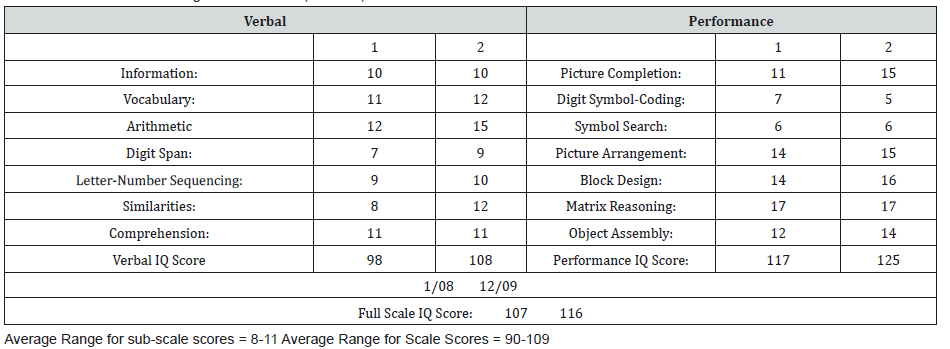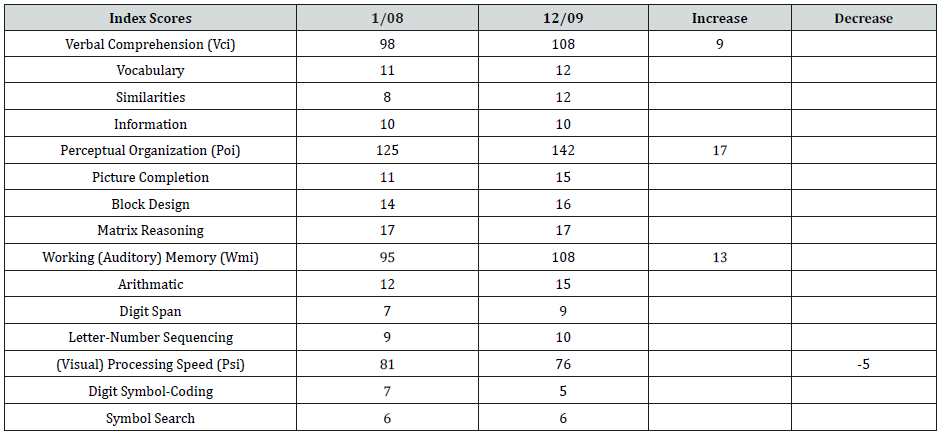 Research Article
Research Article
A Case of Brain Injury on Two Different Occasions: IQ and Halstead-Reitan Test Scores
Seck Lala Bouna, Medical specialties department, Gaston Berger University of Saint Louis, Saint Louis – Senegal.
Received Date: November 19, 2019; Published Date: November 25, 2019
Abstract
This is a brief case report focused on the neuropsychological test scores of a man who suffered two separate brain injuries. His first injury was to the left side of his head when he struck a rock with his head when ocean diving. Approximately 5 years later neuropsychological testing was done as he had lost his job selling technical equipment and had difficulties in functioning on a daily basis. The testing showed clear signs of significant impairment to the left, cerebral hemisphere. Approximately one year after the neuropsychological testing, he suffered another brain injury in an auto accident. Follow-up neuropsychological testing was conducted 11 months after the auto accident, approximately 23 months after the first testing. The second testing demonstrated some clear improvements in cognitive functioning including to his left, cerebral hemisphere. Unfortunately, he not only still demonstrated impaired neuropsychological functioning, he now demonstrated a decrease in performance on a measure particularly sensitive to the right, frontal cerebral cortex.
Case Representation
This is a brief case report of a man who suffered brain injuries on two separate occasions. His first injury was suffered about 5 years prior to the formal neuropsychological testing that was conducted and reported below. He was injured during a diving expedition in the South Pacific. He struck the left side of his head against a rock. As a result of his injuries, he was flown home to the United States. He subsequently had difficulty functioning on the job. In an effort to protect anonymity, I will describe his employment as sales of equipment of a technical nature. Eventually, he was let go from his employment.
He attended a cognitive training program for approximately a year, but did not experience improvement in his functioning and could not return to his employment. Subsequently, he was referred to me for formalneuropsychological testing. Reported below are the most relevant test results from the original testing. It can readily be seen that he has much lower scores for his verbal skills than would be expected given his college education and his occupational attainment. His scores on the sub-tests reflect his impaired concentration and attention (Digit Span and Digit Symbol, which is the most sensitive of the IQ sub-tests to impaired brain functioning. His scores on the Halstead-Reitan Neuropsychological Test Battery clearly reflect his impaired brain functioning. Unfortunately, a year after this testing was done, he was injured in an automobile accident, and repeat testing was conducted 11 months later (approximately 23 months after the first testing. The test results for both test administrations are reported in the Following Tables with the designations (1) and (2) for the two administrations of the IQ test and the Halstead-Reitan battery. A brief comparison of the scores from the two administrations will be provided after the test scores (Table 1-4).
Table 1:Halstead-Reitan Neuropsychological Test Battery.

Table 2:Brain Injury on Two Different Occasions.

Table 3:Wechsler Adult Intelligence Scale – III (WAIS-III).

Table 4:Index Scores.

Discussion
In this Brief Report, I want to simply point out that a couple of major differences can be seen. Thos differences are highlighted in both the absolute magnitude of the differences in his scores as well as in the chart with the gain in his scores from the first testing to the second testing, especially in regard to his scores on perceptual organization skills (17 points), bringing him in the Very Superior range. However, his gain in verbal skills (9 scaled points) reflects improvement in abilities usually associated with the left, cerebral hemisphere, which is where he had struck his head in the (7) years earlier injury. The next most notable change following the second (automobile) injury is his decrease in score on the Digit Symbol- Coding sub-test. This sub-test is especially sensitive to impairments to the right, cerebral hemisphere, especially the frontal cortex, although it can be sensitive to impairments anywhere. Finally, although there are clear improvements in his scores on the Halstead-Reitan Neuropsychological Test Battery, he still shows clear signs of impaired brain functioning at the time of the second testing.
Conclusion
The sad conclusion of the differences in the two sets of test results is that the second testing documents definite improvements in cognitive functioning, but a new injury, probably to the right frontal lobe. This case also provides a demonstration of the power and sensitivity of neuropsychological assessment that includes standardized IQ testing and an established neuropsychological test battery such as the Halstead-Reitan battery.
Acknowledgement
Thanks to the World Federation of Neurology, for its financial support, including the clinical examination tools and the costs of biological and electroneuromyography examinations, that has enabled this study to be carried out.
Conflict of Interest
No financial interest or conflict of interest.
-
Stephen E Berger. A Case of Brain Injury on Two Different Occasions: IQ and Halstead-Reitan Test Scores. Arch Neurol & Neurosci. 5(4): 2019. ANN.MS.ID.000619.
-
Brain Injury, IQ and Halstead-Reitan, Psychology, Neuropsychological, Cerebral hemisphere, Cognitive.
-

This work is licensed under a Creative Commons Attribution-NonCommercial 4.0 International License.






